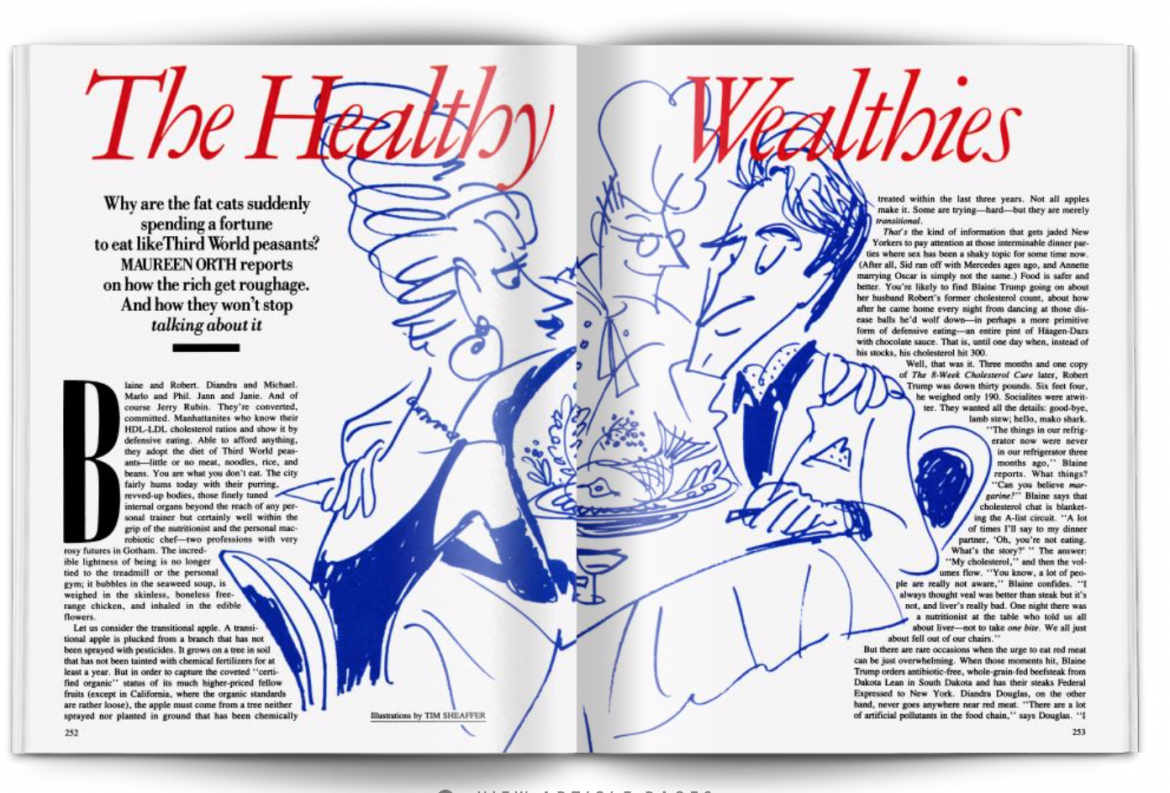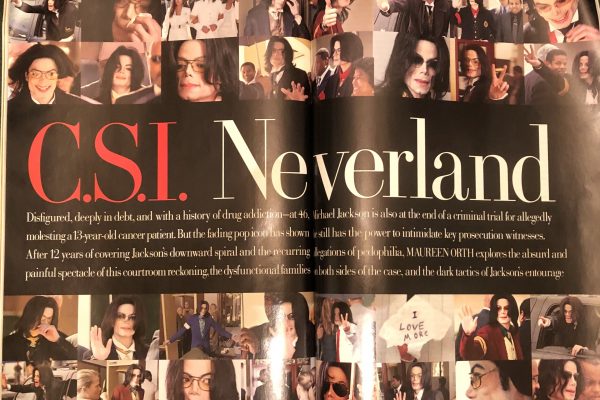Why are the fat cats suddenly spending a fortune to eat like Third World peasants? MAUREEN ORTH reports on how the rich get roughage. And how they won’t stop talking about it.
Blaine and Robert. Diandra and Michael. Marlo and Phil. Jann and Janie. And of course Jerry Rubin. They’re converted, committed. Manhattanites who know their HDL-LDL cholesterol ratios and show it by defensive eating. Able to afford anything, they adopt the diet of Third World peasants—little or no meat, noodles, rice, and beans. You are what you don’t eat. The city fairly hums today with their purring, revved-up bodies, those finely tuned internal organs beyond the reach of any personal trainer but certainly well within the grip of the nutritionist and the personal macrobiotic chef—two professions with very rosy futures in Gotham. The incredible lightness of being is no longer tied to the treadmill or the personal gym; it bubbles in the seaweed soup, is weighed in the skinless, boneless free-range chicken, and inhaled in the edible flowers.
Let us consider the transitional apple. A transitional apple is plucked from a branch that has not been sprayed with pesticides. It grows on a tree in soil that has not been tainted with chemical fertilizers for at least a year. But in order to capture the coveted “certified organic” status of its much higher-priced fellow fruits (except in California, where the organic standards are rather loose), the apple must come from a tree neither sprayed nor planted in ground that has been chemically treated within the last three years. Not all apples make it. Some are trying—hard—but they are merely | transitional.
That’s the kind of information that gets jaded New Yorkers to pay attention at those interminable dinner parties where sex has been a shaky topic for some time now. (After all, Sid ran off with Mercedes ages ago, and Annette marrying Oscar is simply not the same.) Food is safer and better. You’re likely to find Blaine Trump going on about her husband Robert’s former cholesterol count, about how after he came home every night from dancing at those disease balls he’d wolf down—in perhaps a more primitive form of defensive eating—an entire pint of Haagen-Dazs with chocolate sauce. That is, until one day when, instead of his stocks, his cholesterol hit 300.
Well, that was it. Three months and one copy of The 8-Week Cholesterol Cure later, Robert Trump was down thirty pounds. Six feet four, he weighed only 190. Socialites were atwitter. They wanted all the details: good-bye, lamb stew; hello, mako shark. “The things in our refrigerator now were never in our refrigerator three months ago,” Blaine reports. What things? ‘Can you believe margarine?” Blaine says that cholesterol chat is blanketing the A-list circuit. “A lot of times I’ll say to my dinner partner, ‘Oh, you’re not eating. What’s the story?’ ” The answer: “My cholesterol,” and then the volumes flow. “You know, a lot of people are really not aware,” Blaine confides. “I always thought veal was better than steak but it’s not, and liver’s really bad. One night there was a nutritionist at the table who told us all about liver—not to take one bite. We all just about fell out of our chairs.”
But there are rare occasions when the urge to eat red meat can be just overwhelming. When those moments hit, Blaine Trump orders antibiotic-free, whole-grain-fed beefsteak from Dakota Lean in South Dakota and has their steaks Federal Expressed to New York. Diandra Douglas, on the other hand, never goes anywhere near red meat. “There are a lot of artificial pollutants in the food chain,” says Douglas. “I buy regularly from a source which sells organic vegetables, and I never buy anything artificially ripened. I go to a butcher who sells free-range chickens. I think there’s a lot of disease in the U.S. because there is so much sugar, white flour, and red meat in the diet.”
To healthy wealthies, of course, white is blight: no white flour, white rice, white sugar. The new Park Avenue chant: ”The whiter the bread the quicker you’re dead.” Better dramatic black beans, toasty brown oatmeal, deep-orange papaya, and squash. Eat nothing from four legs. ”People really appreciate it when you cook this way for them,” says the shimmeringly chic fashion-marketing maven Kezia Keeble Duka. ”The whole macro thing has changed. People are much less ‘yech’ toward it. There is a lot more than just rice and beans and dried daikon.” No wonder Lee Radziwill has been heard to complain that nobody wants sauces anymore. Not when tofu is so available.
Social arbiters recognize that wretched excess has got to take on new forms. ”The de rigueur model used to be ‘on the floor,’ ” says Rolling Stone publisher Jann Wenner. ”Now that’s far less the case. All the news augurs against excess. Prince is not drugged out every night. Bruce keeps incredibly fit.” Indeed, once the Dark Prince of Pudge himself, the new svelte Wenner claims to ingest vegetables the way he used to ingest other substances. ”I love radishes. I happen to love salads. I eat vegetables all day long. All that is is packaged water.” (Upon hearing this, many who have known Wenner in the past may have to pick themselves up off the floor.) Today, Wenner, who has a gym in his Manhattan apartment and is the father of two little boys aged two and four, has his own cook at home prepare four-hundred-calorie lunches from recipes in the Canyon Ranch cookbook and then has the driver bring them to his Fifth Avenue office. ”By the time you’re forty with children, you don’t take immortality for granted anymore.”
Over on Broadway, that barometer of social change, Jerry Rubin, also munches macro during the lunch hour. He’s had his own macrobiotic chef (his wife prepares her own meals) for five years now. The chef comes to his apartment on Tuesdays and Fridays and leaves him a whole range of grains and steamed veggies which he can reheat in a microwave. “My oat-bran cookies are made from real, concentrated oat bran,” asserts Rubin aggressively. Rubin, now fifty-one and also the father of a two-year-old and an infant, sprinkles vitamin powder on his food. He recently told Longevity magazine, ”Health is the true hedonism as far as I’m concerned. I’m as hedonistic now about health as I was about drugs in the sixties.”
For those who can’t quite afford their own chefs, however, business is brisk all over town for vegetarian takeout. At the Natural Gourmet Cookery School on West Twenty-first Street, for example, two ”I Love New York” shopping bags per week of perfectly balanced yin-yang food are delivered to all the best places for a mere $135. ”This is not a fad,” insists Betsy Sosland, the school’s placement officer in the hotly competitive market for vegetarian chefs. ”This is the next thing. These people have got their personal trainers. They work their bodies like mad, and the results are even better if you eat this way.”
That attitude is fueling the surge of the fast-growing, $3.5 billion health-food industry, which is in the midst of redefining its image and repackaging itself for the affluent consumer. ”We’re shedding our hippie-dippy image,” says Gil Johnson, marketing director of the Natural Foods Merchandiser, the newsletter of the industry. “The trend is to market new products as natural and pure, gourmet and upscale, rather than as health food.” Conservatively speaking, buying organic adds 25 to 30 percent to the price of fruits and vegetables and often much more. Nevertheless, claims Johnson, “within five years it’s going to be hard to count all the organic produce, but it will still not be enough to satisfy the demand.”‘
Mary Estella, thirty-three, a graduate of the prestigious Culinary Institute of America who once cooked for photographer Annie Leibovitz, personifies the new breed of healthy-foods chef. One of her clients is a family with three young children who live in a luxe tower apartment on Central Park West. For about $500 a week, Estella comes by four afternoons to whip up dishes like Tofu Treasures—tofu with peppers, ginger, and garlic, served with basmati rice and yam pie with a nut crust. Her employer, Taya Allison, thirty, shops for the food twice weekly at the organic stalls of New York’s Union Square farmers’ market, where, she says, “I see a hundred people I know.” Allison, a glamorous blonde, claims that her macrobiotic diet makes her and her family feel ”cleaner, more translucent. You can feel the liquid in your body instead of feeling heavy. Your body smells better.”
Most of Estella’s clients begin with a $200 refrigerator makeover—the culinary equivalent of replacing a padded polyester wardrobe with expensive, unstructured natural fibers. “I take your best features [foodwise], habits, and favorite ways to eat and upgrade them,” says Estella. ”We try to replace what your tastes are with better alternatives. ” Like the status grains—quinoa, Job’s tears, roasted buckwheat. It was bound to happen: the high-priced spread getting tossed for natural oils like toasted sesame (the condiment of the moment on steamed vegetables), which comes in tiny bottles and is priced like perfume. Yet for healthy wealthies the refrigerator makeover is the perfect gift, the sublime complement to, say, the treatments of chiropractor/kinesiologist/nutritionist to the stars Linda Li’s recitation of one’s myriad food allergies—she determines what they are by passing a small glass vial of different foods over one’s exposed abdomen; other hot nutritionists use hair analysis.
”I’ve seen worse,” said Estella, a smallish woman with bright brown eyes, peering inside a healthy-but-yet-to-bewealthy writer’s refrigerator. ”At least you don’t have any Cool Whip.” And at the end of several hours and a couple of hundred dollars, the writer’s family had a completely new set of ”breakfast options” on one pristine pantry shelf and ten colors of pasta on another. The cinnamonand nutmeg-type spices and the ”green” condiments were neatly lined up in rows. The dread diet soda had been replaced with bottles of natural juices to be combined with springwater or Perrier. All the fancy new oils were refrigerated too, as was the new natural peanut butter, the organic ketchup, and the all-natural mayo. Most of the refrigerator’s previous inhabitants were in the giveaway bag. Good riddance to bad roughage. Estella ended by grabbing the bottle of distilled white vinegar and putting it under the kitchen sink. ”We only use that to clean with.”
The demand for such knowledge is never-ceasing these days. At the Natural Gourmet Cookery School, founded in 1977 by Annemarie Colbin, ”the Julia Child of natural foods”—and onetime chef for Marlo Thomas—there are classes in everything from ”Healing Your Immune System” to “Holistic Health Care for Your Pet.” Estella often instructs chefs who’ve been sent in from corporate feeders, companies which supply topflight executive dining rooms in New York. In the past few years a number of businesses and blue-chip law firms have gotten very finicky about their diets.
Take the Rockefeller Foundation. It used to be known as a sort of Chablis-and-brie kind of place. Not anymore. These days the staff lunches on salt-free soup flavored with seaweed—made creamy with pureed oatmeal instead of milk— and for dessert they munch cookies devoid of refined sugar. They stir their herbal teas with wooden stirrers because the use of anything not biodegradable is forbidden.
Of course a few holdout carnivores gripe about the vegetarian lunches, “but they’re usually overweight and have a bad attitude,” says an employee of the dining room. The correct tone is set at the top. When the Princess of Thailand dined with the board of trustees, for example, she sent a list of her food allergies ahead of time, and then the proposed vegetarian menu was faxed to her secretary. When Jimmy Carter was the board’s guest, he too requested, and was granted, menu approval. The lone animal protein proffered the former president was the appetizer—smoked salmon with crudites—followed by the entree: oden stew, a root-vegetable stew served with fried tofu.
Not having all one’s employees in culinary harmony is discomforting enough, but think of the problems posed when couples who live together follow two different menus. These are the true mixed marriages. In fact, the Talking Heads’ David Byrne and his wife, Adelle Lutz, were reportedly recently seeking his-and-her macrobiotic chefs because she’s more strict about the food than he is.
By now the healthy-wealthy ethic is so widespread that even the waiters at the city’s best restaurants have become inured to patrons like Sarah Wolkowitz, the vice president of Hot Sox, who like so many others automatically asks whether there is vinegar—forget the oil—in the salad dressing (“I don’t touch anything fermented”), whether the soup is made with a vegetable or chicken base, whether the poultry is freerange, whether the fish is aquafarmed. Inevitably she ends up ordering the vegetable plate. “They used to tell me that Madam should not order the vegetable plate at La Grenouille,” Wolkowitz says. “Now they don’t say a word.”
The Four Seasons reports that fully 35 percent of their orders are for the lighter spa cuisine, and over at Le Cirque the amused Italians are used to bending over backward to honor requests to nix the sauces it’s taken the chef years to perfect. But human nature being what it is, cheating also abounds. Both Julian Niccolini at the Four Seasons and Sirio Maccioni at Le Cirque say that many of the patrons who fastidiously order the light cuisine also down lots of wine and relish big, rich desserts. “Then,” says Sirio, “they put Sweet ‘n Low in their decaffeinated coffee.”
“We’re going through a stage right now where nutrition is on everyone’s mind,” says Glorious Food co-owner Sean Driscoll, who caters Nouvelle Society’s most glittering soirees. “And it’s true that organic food will probably be the thing of the future, but seaweed will never be in with my crowd.” Shame on those white-bred holdouts. “At the end of a meal they’ve paid $1,000 to attend, you cannot give them lean cuisine,” huffs Driscoll.
Ah, but you can let them eat couscous cake.



